|
Comune di Bracciano
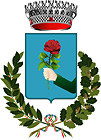
Municipal coat of arms
Country: Italy
Region: Lazio
Province: Rome
Mayor: Enzo Negri (since May 2002)
Elevation: 280 m
Area: 142 km²
Population:
- Total 15,509
- Density 90/km²
Time zone: CET, UTC+1
Coordinates: 42°06'N 12°11'E
Gentilic: Braccianesi
Dialing Code: 06
Postal Code: 00062
Frazioni: Castel Giuliano, Pisciarelli, Sambuco, Vicarello,
Vigna di Valle
Patron: St. Sebastian
Day: January 20
Website: www.comunedibracciano.it
Situato nel complesso craterico degli antichi vulcani dei monti
Sabatini, nel Lazio, il lago di Bracciano, che è
un lago vulcanico, ha una classica forma circolare, una superficie
di 57,5 kmq e una profondità massima di 160 m. Nell'antichità
era conosciuto con il nome di "Lacus Sabatinus". Sulle
coste del lago ci sono tre centri storici, Bracciano, Anguillara
Sabazia e Trevignano, nei quali possono essere ammirati il castello
degli Orsini-Odescalchi, gli imponenti resti di una villa romana,
e i resti dell'acquedotto di Traiano.
Bracciano is a small town in
the Italian region of Lazio, 30 km northwest of Rome. The town
is famous for its volcanic lake (Lago di Bracciano or "Sabatino",
the eighth largest lake in Italy) and for a particularly well-preserved
medieval castle. The lake is widely used for sailing and is popular
with tourists; the castle has hosted a number of events, especially
weddings of actors and singers. Bracciano is reachable in 45 minutes
from Rome's railway stations of Valle Aurelia and Ostiense. Close
to it lie the two medieval towns of Anguillara Sabazia and Trevignano
Romano.
History
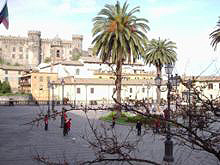 Situated
in the complex of crateric cavities of the ancient Sabatini volcanos,
in Lazio region, the lago of Bracciano has a classic circular
shape, a surface of 57,5 sq Km and 160 mt. of maximum depth. In
antiquity it was known with the name of "Lacus Sabatinus".
It's a volcanic lake. On the coast of the lake are the three historical
centers of Bracciano, Anguillara Sabazia and Trevignano, in which
the Orsini-Odescalchi castle, the imposing rests of a roman villa,
the remains of the aqueduct of Traiano can be admired. Situated
in the complex of crateric cavities of the ancient Sabatini volcanos,
in Lazio region, the lago of Bracciano has a classic circular
shape, a surface of 57,5 sq Km and 160 mt. of maximum depth. In
antiquity it was known with the name of "Lacus Sabatinus".
It's a volcanic lake. On the coast of the lake are the three historical
centers of Bracciano, Anguillara Sabazia and Trevignano, in which
the Orsini-Odescalchi castle, the imposing rests of a roman villa,
the remains of the aqueduct of Traiano can be admired.
The lake as seen from Largo Falcone and Borsellino, near the castle.
There is no certain information about the origins of Bracciano,
on the Via Claudia overlooking the lake. It probably rose from
one of the numerous towers built in the tenth century as a defence
against the Saracen attacks, as implied by the ancient name of
Castrum Brachiani. In the eleventh century the neighbouring territory
was acquired by the Prefetti di Vico family, who turned the tower
into a castle. Ferdinand Gregorovius dated the possession of Bracciano
by the Orsini to 1234. The area was later acquired by the Roman
hospital of Santo Spirito in Sassia and, from 1375, was a Papal
possession.
In 1419 the Colonna Pope Martin V confirmed the fief of Bracciano
in the Orsini family branch of Tagliacozzo. Under this powerful
family the city developed into a flourishing town, famous in the
whole of Italy for its castle, which was enlarged, starting from
1470, by Napoleone Orsini and his son Virginio. In 1481 it housed
Pope Sixtus IV, who had fled from the plague in Rome; the Sala
Papalina in one of the corner towers commemorates the event. Four
years later, however, the city and the castle were ravaged by
Papal troops under Prospero Colonna, and subsequently a new line
of walls was built.
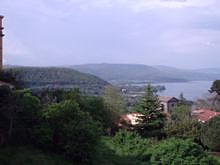 In
1494 Charles VIII of France and his troops marching against Rome
stopped at Bracciano. This act led to the excommunication of the
Orsini, and in 1496 the city was besieged by a papal army headed
by Giovanni di Candia, son of Pope Alexander VI Borgia, though
it resisted successfully. Cesare Borgia, another of Alexander's
natural sons, was unsuccessful in his attempt to take the Orsini
stronghold a few years later. The sixteenth century was a period
of splendour for Bracciano. In 1558 the notorious Paolo Giordano
I Orsini, marrying Isabella de' Medici, daughter of Cosimo I,
Grand Duke of Tuscany, received the title of duke of Bracciano.
The economy was boosted by the exploitation of sulphur and iron,
the production of tapestries and paper. The latter was favoured
by the construction of an aqueduct whose ruins can be still seen
in the city. Bracciano in this period had some 4,500 inhabitants. In
1494 Charles VIII of France and his troops marching against Rome
stopped at Bracciano. This act led to the excommunication of the
Orsini, and in 1496 the city was besieged by a papal army headed
by Giovanni di Candia, son of Pope Alexander VI Borgia, though
it resisted successfully. Cesare Borgia, another of Alexander's
natural sons, was unsuccessful in his attempt to take the Orsini
stronghold a few years later. The sixteenth century was a period
of splendour for Bracciano. In 1558 the notorious Paolo Giordano
I Orsini, marrying Isabella de' Medici, daughter of Cosimo I,
Grand Duke of Tuscany, received the title of duke of Bracciano.
The economy was boosted by the exploitation of sulphur and iron,
the production of tapestries and paper. The latter was favoured
by the construction of an aqueduct whose ruins can be still seen
in the city. Bracciano in this period had some 4,500 inhabitants.
However, the expensive tenor of life of the Orsini eventually
damaged the economic conditions of the city. The last great ruler
was probably Paolo Giordano II, a patron of arts and literature
which made Bracciano a center of culture in Italy. The decline
culminated in 1696 when the castle was sold to Livio Odescalchi,
nephew of Pope Innocent XI; the Odescalchi family still retain
the castle.
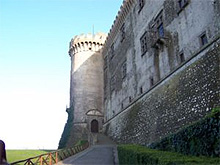 A
view of the Castello Orsini-Odescalchi. A
view of the Castello Orsini-Odescalchi.
In the castle, richly frescoed friezes and ceilings now contrast
with blank walls, which were hung with richly-coloured tapestries
when the lords of Bracciano were in residence. Actors Tom Cruise
and Katie Holmes had their wedding in the castle on 18th November
2006.
The main economic activities are tourism, services and agriculture.
Until the twentieth century the region was notoriously unhealthy
for its malaria, now eradicated; as a result, none of the fine
villas were built at the water's edge, but all stood on healthier
rises of ground.
Main sights
This section is a stub. You can help by expanding it.
The main monument of Bracciano is its castle, Castello Orsini-Odescalchi,
one of the most noteworthy examples of Renaissance military architecture
in Italy.
3 km outside the city, alongside the road leading to Trevignano
Romano, is the ancient church of San Liberato (ninth century).
It occupies what was once the Roman settlement of Forum Clodii,
now surrounded by an herb garden, part of the complex of English-style
gardens at the adjoining Villa San Librato, designed by Russell
Page in 1965 for the art historian conte Donato Sanminatelli and
his contessa, Maria Odescalchi, and carried out over the following
decade.
On the same road are the ruins of the Aquae Apollinaris, a complex
of baths famous in the Roman age.
At Vigna di Valle, facing the lake, an ancient hydroplane base
houses today the museum of the Aeronautica Militare Italiana.
The show include most of the historical Italian military aircraft,
including famous planes such as the MC. 202, the Supermarine Spitfire,
the Savoia Marchetti S.79, the F-104 Starfighter and the Panavia
Tornado.
See also
Orsini
Lake
of Bracciano
Notes
Bracciano is pronounced in three syllables: "Bra-CHA-no"
External links
Bracciano
Castello
Orsini-Odescalchi
Roberto
Piperno, "Bracciano"
Sailing and Windsurf on Lake Bracciano &
Trevignano Romano
Circolo Velico Planet Sail (Bracciano)
Weekly sailing courses for kids and adults on Optimist, Laser,
Caravel or Flying Junior, FIV certified and english speaking
staff, sailing boat and windsurf rent for members, boat and
windsurf laying up for members.
|
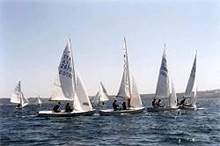 |
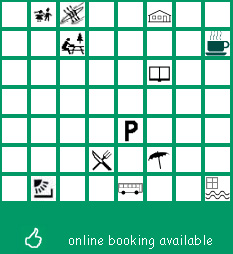 |
D'artagnan Boat Tours (Bracciano)
Electric boat rent for small groups up to 20 persons.
|
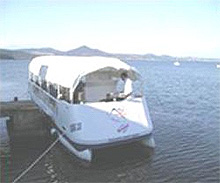 |
 |
Centro Velico 3 V (Trevignano Romano)
Sailing boat rent: HobieCat, Alap 550, Vaurien, Laser, Soling,
Optimist. Sailing school for beginners and experts,FIV certified
staff; boat and windsurf laying up.
|
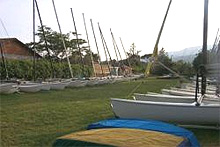 |
 |
|